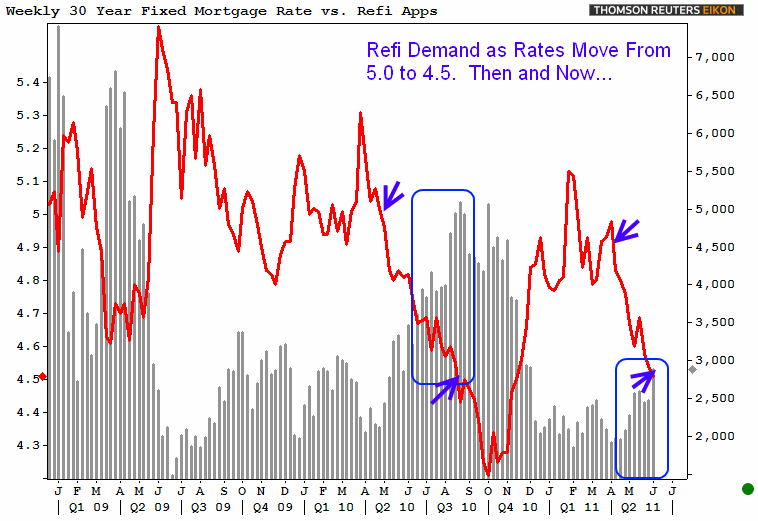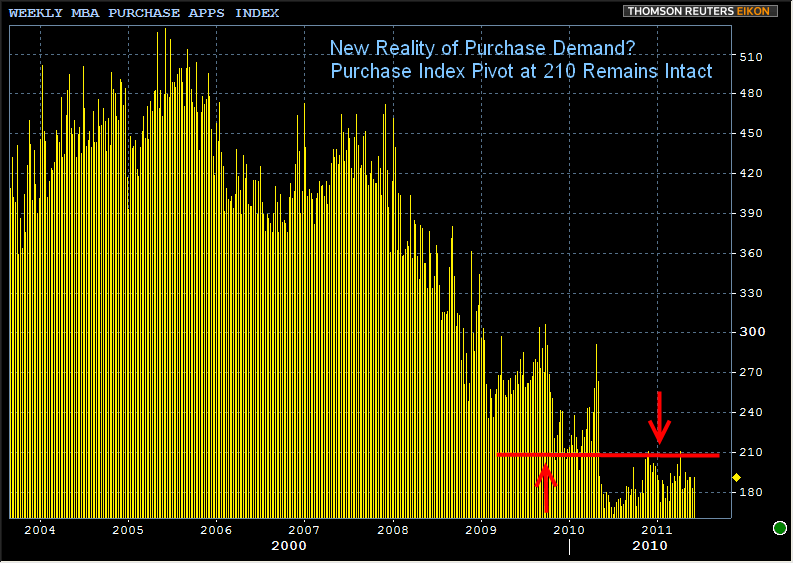Blog

Refi Demand Finally Reacts to Falling Mortgage Rates
The Mortgage Bankers Association (MBA) today released its Weekly MortgagernApplications Survey* for the week ending June 7, 2011.</p
The Refinance Index ticked up noticeably in the last week, from 2475 torn2883, the highest reading since November 2010. rnThis is bittersweet as it finally showed some linear connectionrnbetween falling rates and refi demand…only to have rates rise this week. Even so, the last time rates fell from 5.0 torn4.5 as they have in 2011, readings around 3000 on the refi index representedrnthe LOW END, moving over 5000 on the index by the time rates hit the samernreported level as they did last week. </p
 </p
</p
Plain and Simple: The same historically low rates are producing only arnlittle more than half the refi demand as last fall, providing a stark picturernof the current lending environment.</p
The Purchase Index was fairlyrnuneventful last week. Although it rosernfrom 182.9 to 191.1, that puts it right in line with a majority of previousrnweeks. In fact, 2 out of every 3 weeksrnsince March have been within 5 points of 190. rnPretty darn stagnant. With thernexception of the horrible levels under 170 in the summer of 2010, we’re sidewaysrnat the lowest levels in the history of MBA’s reporting with a clear pivot pointrnaround 210 separating past and present. </p
 </p
</p
Excerpts from the Release…</p
The Market Composite Index, a measure of mortgage loanrnapplication volume, increased 13.0 percent on a seasonally adjusted basis fromrnone week earlier. On an unadjusted basis, the Index increased 24.5 percentrncompared with the previous week, which included Memorial Day. The RefinancernIndex increased 16.5 percent from the previous week. The seasonally adjustedrnPurchase Index increased 4.5 percent from one week earlier. The unadjustedrnPurchase Index increased 14.2 percent compared with the previous week and wasrn6.1 percent higher than the same week one year ago.</p
“Mortgage rates have declined for 8 of the past 9rnweeks. Coming off of the Memorial Day holiday, refinance application volumernincreased significantly, as borrowers jumped to lock in the lowest mortgagernrates since last November,” said Michael Fratantoni, MBA’s Vice Presidentrnof Research and Economics. “The volume of refinance applications stillrnremains 28 percent below levels seen at that time, as borrowers with anrnincentive to refinance remain constrained from doing so by lack of equity inrntheir homes.”</p
The four week moving average for the seasonally adjustedrnMarket Index is up 2.4 percent. The four week moving average is up 0.3 percentrnfor the seasonally adjusted Purchase Index, while this average is up 3.1rnpercent for the Refinance Index.</p
The refinance share of mortgage activity increased to 70.0rnpercent of total applications from 67.3 percent the previous week. This is thernhighest refinance share since January 21, 2011. The adjustable-rate mortgagern(ARM) share of activity remained unchanged at 6.1 percent of total applicationsrnfrom the previous week.</p
The average contract interest rate for 30-year fixed-raternmortgages decreased to 4.51 percent from 4.54 percent, with points increasingrnto 1.05 from 0.94 (including the origination fee) for 80 percent loan-to-valuern(LTV) ratio loans. This is the lowest 30-year average rate since November 19,rn2010. The effective rate also decreased from last week. </p
The average contract interest rate for 15-year fixed-raternmortgages remained unchanged at 3.67 percent, while points also remainedrnunchanged at 1.06 (including the origination fee) for 80 percent LTV loans.rnThis is the lowest 15-year average contract rate since November 5, 2010. Therneffective rate increased from last week.</p
*The MBA’s loan application survey covers over 50% of allrnU.S. residential mortgage loan applications taken by mortgage bankers,rncommercial banks, and thrifts. The data gives economists a snapshot view ofrnconsumer demand for mortgage loans. In a falling mortgage rate environment, arntrend of increasing refinance applications implies consumers are seeking outrnlower monthly payments. If consumers are able to reduce their monthly mortgagernpayment and increase disposable income through refinancing, it can be arnpositive for the economy as a whole (may boost consumer spending. It alsornallows debtors to pay down personal liabilities faster. A trend of decliningrnpurchase applications implies home buyer demand is shrinking.
All Content Copyright © 2003 – 2009 Brown House Media, Inc. All Rights Reserved.nReproduction in any form without permission of MortgageNewsDaily.com is prohibited.
Latest Articles
By John Gittelsohn August 24, 2020, 4:00 AM PDT Some of the largest real estate investors are walking away from Read More...
Late-Stage Delinquencies are SurgingAug 21 2020, 11:59AM Like the report from Black Knight earlier today, the second quarter National Delinquency Survey from the Read More...
Published by the Federal Reserve Bank of San FranciscoIt was recently published by the Federal Reserve Bank of San Francisco, which is about as official as you can Read More...

Comments
Leave a Comment